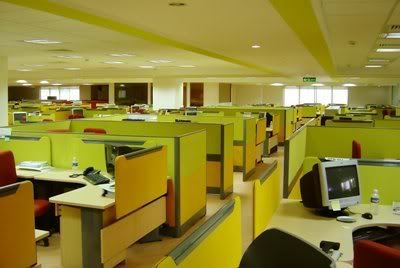Rethinking Office Cubicles?

Image of cubicles © Arjun Kartha.
Office cubicles just work for many companies. They’re compact, efficient working spaces. They rationalize the use of office space. Finally, office cubicles offer an egalitarian solution that many highly-stratified companies turn to when communication breaks down between layers in the corporate hierarchy.
But has the time come to reconsider cubicles?
Consider this: layoffs are decimating the workforce – gaps in the cubicle village are starting to show. The space-saving cubicle is becoming obsolete in offices with office space to spare.
At the same time, a growing chunk of the remaining workforce has a different view of cubicle hierarchy: the enclosed walls clash with a millennial generation that values face time.
“Office design is going from an ‘I’ to ‘we’ concept,” says designer Collin Burry of Gensler, the global architectural and design firm. “Millennials would be miserable sitting in a closed office all day long.”
Companies now face the challenge of integrating the differing workspace demands of multiple generations within the same office. Case in point, healthcare concern McKesson and their redesigned office space:
McKesson […] has been forced to accommodate three generations of workers with three different workplace expectations.
Boomers still desire the entitlements of an individual working space; middle-aged workers (Gen X-ers) don’t require as much space, yet still value a personal station; and millennials, who are unattached to personal space, are comfortable working from home or cafes and tend to view offices and high-walled cubicles as dead zones.
“There still is a place to go to do heads-down work,” Robinson said of the redesigned headquarters. “But it’s just not yours to keep.”
The open-office space that millennials prefer doesn’t work at every office, though. Chevron discovered this the hard way, when the corporate culture clashed with the revised office layout:
By tearing down walls that once separated the rank and file from executives and curtailed collegial interaction, the company expected operations to become more efficient.
While it did work in terms of increasing collaboration among some groups, others found it distracting.
“They received a lot of feedback from business units that said, ‘This really isn’t supporting our work habits really well,’” said Smead, who was involved in the redesign.
So who wins?
There’s still room for the cubicle in the workspace; there will always be offices where hierarchy and efficiency are important. But the push and pull between the open-spacers and the cubiclists will probably go on for some time; winner TBA.
(If the open-spacers win, we’re not worried at all… we’ll just sell them more desks and chairs!)
« New Generation Office Chair Flexes its Muscle. Next Post
Herman Miller: Where Green Manufacturing is Company Tradition. »


3:54 pm
I think it’s very true that Gen Y and even Gen Z are coming to appreciate that open plan actually does prove more effective business-wise.